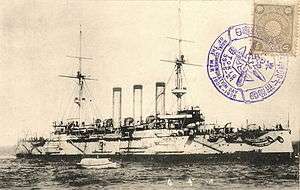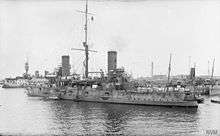2nd Special Squadron (Japanese Navy)
| 2nd Special Squadron | |
|---|---|
| Active | 10 February 1917 – 2 July 1919 |
| Country | Japan |
| Branch |
|
| Type | Fleet |
| Role | Protection shipping in the Mediterranean theater of operations. |
| Part of | Admiral, Japanese Command |
The 2nd Special Squadron (10 February 1917 – 2 July 1919) was an Imperial Japanese Navy fleet. In accordance with the Anglo-Japanese Alliance, the fleet helped defend Allied shipping in the Mediterranean theater of operations of World War I.
Background
Troubled by the expansion of Russian influence in India, Korea and Manchuria, the British and Japanese Empires signed the Anglo-Japanese Alliance in 1902. The treaty was renewed in 1905 following Russia's defeat in the Russo-Japanese War, the focus of the alliance shifted towards Germany. In October 1911, Winston Churchill was appointed to the position of First lord of the Admiralty, he sought to counter the potential threat posed by Germany in the North Sea by redeploying warships from the China Seas and the Mediterranean. The two countries renewed the treaty once again as Britain intended to relegate the responsibility of safeguarding its shipping in the Pacific and the Mediterranean to Japan and France respectively, in the event of a war. In 1914, the Imperial Japanese Navy was divided into three fleets. The 1st Fleet was commanded by vice admiral Katō Tomosaburō and consisted of the navy's most modern battleships and battlecruisers. The 2nd Fleet was largely formed of captured Russian ships and some cruisers, it was commanded by Katō Sadakichi. The 3rd Fleet was stationed in the South China Sea, it was composed of cruisers and cannon boats. Its total strength amounted to 50 destroyers, 14 battleships and battlecruisers, 13 armored cruisers, 10 lighter cruisers and old cruisers.[1][2]
On 7 August 1914, Britain requested Japan to destroy the German East Asia Squadron. On 15 August, Japan issued Germany an ultimatum demanding the handover of the Kiautschou Bay concession and that German ships abandon Chinese waters, thus intervening into World War I on the side of the Triple Entente. With the expiration of the ultimatum Japan officially declared war on Germany, blockading, besieging and eventually capturing Tsingtao. In September, the 1st and 2nd South Sea Squadrons of the were dispatched towards German New Guinea, where they occupied the German administrative centers in Rabaul, the Caroline Islands, Palau, Mariana Islands and Marshall Islands. The Japanese navy subsequently participated in the pursuit of the German East Asia Squadron through the Indian and Pacific oceans.[1]
On 2 September 1914, Britain requested Japan to send a division of their navy into the Mediterranean theater of operations, in order to counter the threat posed by the Ottoman and Austro-Hungarian navies as well as the German Mediterranean Division. Japan declined citing its involvement in the blockade of Tsingtao and the Pacific Ocean operations. On 4 November, Britain reiterated their proposal offering to support Japanese claims at the conclusion of the war. This proposal was refused after chief of national staff Shimamura Hayao voiced the opinion that the presence of a Japanese force at such a distance from the homeland would create a risk of an American invasion. The British persisted by approaching the Japanese naval attache in London in December 1914 and 13 January 1915, who promptly rebuffed them. Negotiations were resumed on 2 February 1916, whereupon it was agreed that Australia will sign the Anglo–Japanese Commercial Treaty, Japanese immigrants will be granted entry into Australia and New Zealand, while Japanese doctors will be allowed to practice in British colonies. The above concessions in tandem with the appointment of Terauchi Masatake (who advocated wider cooperation) to the post of Prime Minister of Japan, led to the creation of the 1st Special Squadron that was tasked with escorting troopships from Australia and New Zealand to the Aden Protectorate as well as patrol duties on the same route. Japanese assistance was extended on 10th February 1917, when it was decided that a 2nd Special Squadron was to be created. [3]
2nd Special Squadron
The squadron was headed by the Suma-class cruiser Akashi, while also including the 10th (Ume, Kusunoki, Kaede, Katsura) and 11th (Kashiwa, Matsu, Sugi, and Sakaki) Destroyer Flotillas, consisting of 4 Kaba-class destroyers each. The 11th Flotilla departed Japan on 18 February 1917, joining the rest of the squadron in Singapore on 5 March, where Admiral Kōzō Satō assumed command. The squadron sailed through Colombo, Aden and Port Said, arriving at Malta on 16 April. The arrival of the squadron coincided with the peak of the unrestricted submarine warfare practiced by the Central Powers.[4][5]
The Japanese were tasked with escorting troopships heading from Malta to Salonica and from Alexandria to Taranto and Marseille. On 4 May 1917, Sakaki and Matsu took part in the rescue of the passengers of British transport SS Transylvania, which was sinking after being torpedoed off the Gulf of Genoa, almost 3,000 people were saved. The British Admiralty later sent a telegram congratulating Satō for the service of his men on that occasion. In June 1917, Izumo-class cruiser cruiser Izumo relieved Akashi at Malta becoming the squadron's flagship. On 11 June 1917, Sakaki was torpedoed by German submarine SM UC-27 off the coast of Crete, resulting in 59 deaths and 22 injuries. Sakaki was badly damaged, however she managed to reach the port of Pireaus. On 25 June 1917, the 15th Destroyers Flotilla comprised four Momo-class destroyers (Momo, Kashi, Hinoki, Yanagi) departed from Japan, joining the squadron in August 1917. On 27 August 1917, admiral superintendent of the Malta Dockyard George Alexander Ballard praised the operational capacity of the Japanese, favorably comparing them towards those of the French and Italians. In 1918, Kasuga-class cruiser Nisshin reinforced the squadron, becoming a flagship in November of the same year.[6][7][8][5]
By the end of the war ships belonging to the squadron had accompanied 788 Allied ships, including transports carrying 700,000 troops. They engaged German and Austro–Hungarian submarines on 38 occasions failing however to sink any. In December 1918, Izumo, accompanied by the destroyers Hinoki and Yanagi, sailed from Malta to Scapa Flow to assume control of seven captured German U-boats as prizes of war. The crew of the ships took part in the 1919 Paris and London Victory Parades. They returned to Malta with the U-boats in March 1919 and Nisshin accompanied eight destroyers and the U-boats to Japan, while Izumo made port calls at Naples, Genoa and Marseilles before arriving in Japan with the remaining destroyers on 2 July 1919.[7][4][5]
A memorial commemorating the fallen servicemen from Sakaki was opened at the Kalkara Naval Cemetery in Malta.[9]
Ships of the 2nd Special Squadron
- Cruisers
| Name | Image | Launched | Type |
|---|---|---|---|
| Akashi |  |
December 18, 1897 | Suma class |
| Izumo |  |
September 19, 1898 | Izumo class |
| Nisshin |  |
February 9, 1903 | Kasuga class |
- 10th Destroyer Flotilla
| Name | Image | Launched | Type |
|---|---|---|---|
| Ume | — | February 27, 1915 | Kaba class |
| Kusunoki | — | March 5, 1915 | Kaba class |
| Kaede | — | February 20, 1905 | Kaba class |
| Katsura |  |
February 15, 1915 | Kaba class |
- 11th Destroyer Flotilla
| Name | Image | Launched | Type |
|---|---|---|---|
| Kashiwa | — | February 14, 1915 | Kaba class |
| Matsu | — | March 5, 1915 | Kaba class |
| Sugi | — | February 16, 1915 | Kaba class |
| Sakaki | — | March 4, 1915 | Kaba class |
- 15th Destroyer Flotilla
| Name | Image | Launched | Type |
|---|---|---|---|
| Momo | — | October 12, 1916 | Momo class |
| Kashi | — | December 1, 1916 | Momo class |
| Hinoki |  |
December 25, 1916 | Momo class |
| Yanagi | — | February 24, 1917 | Momo class |
See also
- 1st Special Squadron (Japanese Navy) - Fleet assigned to patrol Australia
- North American Task Force - Fleet assigned to patrol Canada and later the West Pacific
- Third Fleet (Imperial Japanese Navy) - Fleet assigned to patrol Russian coast during the Soviet Revolution
- 2nd Fleet (Imperial Japanese Navy) was a fleet of the Imperial Japanese Navy (IJN) created as a mobile strike force in response to hostilities with Russia, and saw action in every IJN military operation until the end of World War II.
- 1st Fleet (Imperial Japanese Navy)
Notes
- 1 2 Pocher 2015, pp. 345–358.
- ↑ Saxon 2000, pp. 1–5, 13.
- ↑ Hirama 1998, pp. 41–45.
- 1 2 Saxon 2000, p. 12–16.
- 1 2 3 Hirama 1998, pp. 45–54.
- ↑ "U-boats for French Port". Aberdeen Evening Express. 10 December 1918. p. 4. Retrieved 10 March 2015 – via British Newspaper Archive. (Subscription required (help)).
- 1 2 Hackett & Kingsepp 2014.
- ↑ Saxon 2000, p. 12–16, 1.
- ↑ Zammit, Roseanne (27 March 2004). "Japanese lieutenant's son visits Japanese war dead at Kalkara cemetery". Times of Malta. Retrieved 25 May 2015.
References
- Hackett, Bob & Kingsepp, Sander (2014). "HIJMS Izumo: Tabular Record of Movement". SOKO-JUNYOKAN – Ex-Armored Cruisers. Combinedfleet.com. Retrieved 23 April 2015.
- Hirama, Yochi (1998). "Rising Sun in the Mediterranean:The Second Special Squadron,1917–18". Proceedings of Il Mediterraneo quale elemento del potere marittimo. Commissione Italiana di Storia Militare- Ufficio Storico della Marina Militare: 39–54. Retrieved 8 May 2016.
- Saxon, Timothy (2000). "Anglo-Japanese Military Cooperation, 1914–1918". Naval War College Review. Liberty University. 53 (1): 1–26. Retrieved 8 May 2016.
- Pocher, Harald (2015). "Japan in the First World War". Military Science Review/Hadtudományi Szemle. 8 (1): 341–358.
External links
- "MOVEMENTS OF JAPANESE WARSHIPS IN THE MEDITERRANEAN". Imperial War Museum. Retrieved 23 December 2016.